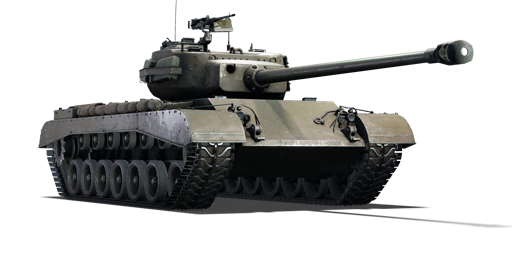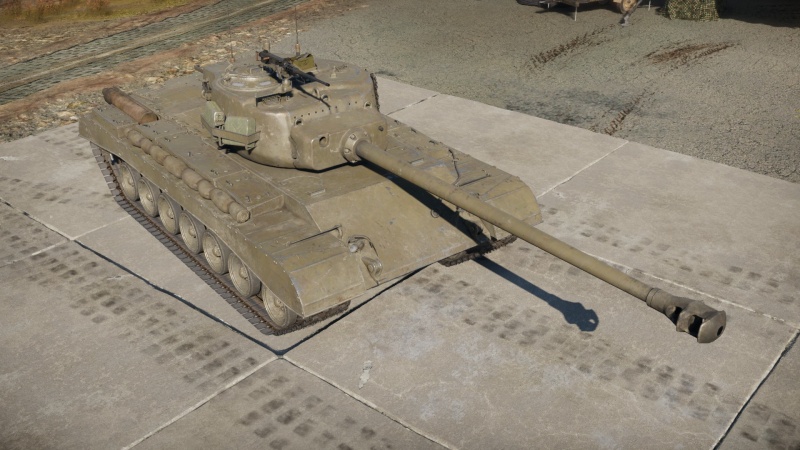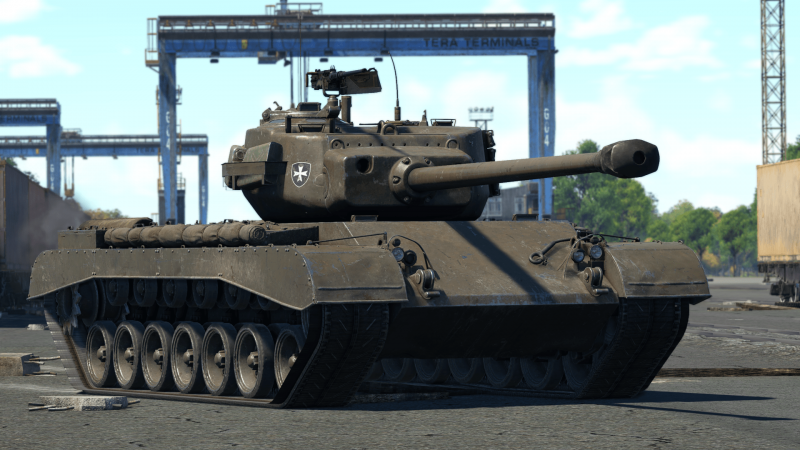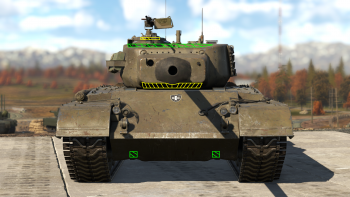Difference between revisions of "T32E1"
(→Ammunition: Converted to transclusion) |
(Survivability and armour description added. Tank weak spots picture added.) |
||
| Line 19: | Line 19: | ||
{{Specs-Tank-Armour}} | {{Specs-Tank-Armour}} | ||
<!-- ''Describe armour protection. Note the most well protected and key weak areas. Appreciate the layout of modules as well as the number and location of crew members. Is the level of armour protection sufficient, is the placement of modules helpful for survival in combat? If necessary use a visual template to indicate the most secure and weak zones of the armour.'' --> | <!-- ''Describe armour protection. Note the most well protected and key weak areas. Appreciate the layout of modules as well as the number and location of crew members. Is the level of armour protection sufficient, is the placement of modules helpful for survival in combat? If necessary use a visual template to indicate the most secure and weak zones of the armour.'' --> | ||
| + | |||
| + | [[File:T32E1 weak spots.png|right|thumb|350px|Green area = easy chance of penetration; yellow area = medium chance of penetration]] | ||
| + | |||
| + | The T32E1 uses the same turret as its predecessor, T32, with 289.4 mm cast homogeneous armour thickness in the gun mantlet and turret cheeks that makes it almost impenetrable by full calibre (AP, APC, APCBC) and sub-calibre (APCR) rounds; the only ammunition capable to defeat its protection are high velocity (APDS), kinetic (APFSDS) and chemical (HEAT, HEATFS). | ||
| + | |||
| + | The biggest improvement is the new hull that eliminated weak spots from the T32 hull as the machinegunner port, the new roof has 66.6 mm of rolled homogenous armour, making it invulnerable for high explosive rounds, the frontal hull still has the same thichness from the T32 (127 mm on the top and 95.25 mm on the bottom) but with a slightly sloped armour that varies from 54° to 56°. | ||
{| class="wikitable" | {| class="wikitable" | ||
Revision as of 16:33, 28 February 2024
| This page is about the American heavy tank T32E1. For other versions, see T32 Heavy Tank (Family). |
Contents
Description
The Heavy Tank T32E1 is a rank V American heavy tank with a battle rating of 7.7 (AB/RB/SB). It was introduced in Update 1.83 "Masters of the Sea".
Being the next stage of its development cycle, the T32E1 is essentially the same as the T32 except the designers replaced the cast homogeneous plates of the front hull in favour of simpler rolled homogeneous ones, deleting the hull machine gun port in the process. This not only removes an obvious weakness from the design, but it also strengthened the front hull plate from penetrations.
General info
Survivability and armour
The T32E1 uses the same turret as its predecessor, T32, with 289.4 mm cast homogeneous armour thickness in the gun mantlet and turret cheeks that makes it almost impenetrable by full calibre (AP, APC, APCBC) and sub-calibre (APCR) rounds; the only ammunition capable to defeat its protection are high velocity (APDS), kinetic (APFSDS) and chemical (HEAT, HEATFS).
The biggest improvement is the new hull that eliminated weak spots from the T32 hull as the machinegunner port, the new roof has 66.6 mm of rolled homogenous armour, making it invulnerable for high explosive rounds, the frontal hull still has the same thichness from the T32 (127 mm on the top and 95.25 mm on the bottom) but with a slightly sloped armour that varies from 54° to 56°.
| Armour | Front (Slope angle) | Sides | Rear | Roof |
|---|---|---|---|---|
| Hull | 127 mm (58°) Upper glacis 127mm (18°) + 95.3 (58°) mm Seam 95.3 mm (40-59°) Lower glacis |
76.2 mm | 50.8 mm | 66.6 mm Crew compartment 25.4 mm Engine compartment |
| Turret | 298.4 mm (8-21°) Turret front 298.4 mm (0-80°) Gun mantlet |
152.4 - 196 mm (3-42°) | 152.4 mm (0-72°) | 25.4 mm |
| Cupola | 152 mm | 152 mm | 152 mm | 25 mm |
Mobility
| Game Mode | Max Speed (km/h) | Weight (tons) | Engine power (horsepower) | Power-to-weight ratio (hp/ton) | |||
|---|---|---|---|---|---|---|---|
| Forward | Reverse | Stock | Upgraded | Stock | Upgraded | ||
| Arcade | 38 | 15 | 54 | 994 | 1,469 | 18.41 | 27.2 |
| Realistic | 36 | 14 | 681 | 770 | 12.61 | 14.26 | |
Modifications and economy
Armaments
Main armament
| 90 mm T15E2 | Turret rotation speed (°/s) | Reloading rate (seconds) | |||||||||||
|---|---|---|---|---|---|---|---|---|---|---|---|---|---|
| Mode | Capacity | Vertical | Horizontal | Stabilizer | Stock | Upgraded | Full | Expert | Aced | Stock | Full | Expert | Aced |
| Arcade | 54 | -10°/+20° | ±180° | N/A | 19.4 | 26.9 | 32.6 | 36.1 | 38.4 | 18.85 | 16.68 | 15.37 | 14.50 |
| Realistic | 14.3 | 16.8 | 20.4 | 22.6 | 24.0 | ||||||||
Ammunition
| Penetration statistics | |||||||
|---|---|---|---|---|---|---|---|
| Ammunition | Type of warhead |
Penetration @ 0° Angle of Attack (mm) | |||||
| 10 m | 100 m | 500 m | 1,000 m | 1,500 m | 2,000 m | ||
| T43 shot | APBC | 211 | 208 | 193 | 177 | 162 | 148 |
| T42 shell | HE | 26 | 25 | 24 | 22 | 20 | 18 |
| T41 | APCBC | 224 | 220 | 205 | 187 | 171 | 157 |
| T44 shot | APCR | 336 | 330 | 304 | 274 | 248 | 223 |
| Shell details | ||||||||||||
|---|---|---|---|---|---|---|---|---|---|---|---|---|
| Ammunition | Type of warhead |
Velocity (m/s) |
Projectile mass (kg) |
Fuse delay (m) |
Fuse sensitivity (mm) |
Explosive mass (TNT equivalent) (g) |
Ricochet | |||||
| 0% | 50% | 100% | ||||||||||
| T43 shot | APBC | 975 | 10.9 | - | - | - | 47° | 60° | 65° | |||
| T42 shell | HE | 975 | 10.6 | 0.2 | 0.1 | 925 | 79° | 80° | 81° | |||
| T41 | APCBC | 975 | 10.91 | 1.2 | 14 | 137.2 | 48° | 63° | 71° | |||
| T44 shot | APCR | 1,143 | 7.6 | - | - | - | 66° | 70° | 72° | |||
Ammo racks
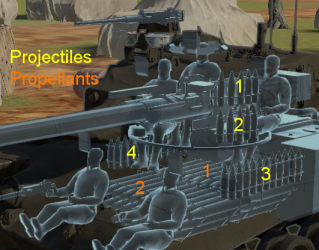
| Full ammo |
Ammo part |
1st rack empty |
2nd rack empty |
3rd rack empty |
4th rack empty |
Visual discrepancy |
|---|---|---|---|---|---|---|
| 54 | Projectiles Propellants |
50 (+4) 28 (+26) |
45 (+9) 1 (+53) |
23 (+31) N/A |
1 (+53) N/A |
No |
Notes:
- The T32E1 uses two-piece ammunition, composed of projectiles (yellow) and propellant bags (orange). Both have separate racks.
- Packs 23 (+31) shells to have the turret and left flank racks empty.
The cannon takes two-piece ammunition, which explains why it takes so long for the cannon to load despite its 90 mm calibre. The propellant stowage covers the entire floor of the fighting compartment three times over. The projectiles themselves are kept in four racks, two lining both sides of the hull's fighting compartment, and two smaller ones on the port side of the turret in front of the loader.
Machine guns
| 12.7 mm M2HB | ||||
|---|---|---|---|---|
| Mount | Capacity (Belt) | Fire rate | Vertical | Horizontal |
| Pintle | 1,000 (200) | 577 | -10°/+35° | ±120° |
| 7.62 mm M1919A4 | ||||
|---|---|---|---|---|
| Mount | Capacity (Belt) | Fire rate | Vertical | Horizontal |
| Coaxial | 4,000 (250) | 500 | N/A | N/A |
Usage in battles
The playstyle of the T32E1 is vastly different in each game mode, due to the nature of the gameplay available in Ground Forces:
Arcade battles
- Player, ally, and enemy position will be immediately spotted upon detection with their name indicator visible above their vehicle and on the minimap
- Aim assist is present to help accurate aiming at a target
- Player and enemy team tank's nationality are mixed
The T32E1 shouldn't be exposed to the enemy at a prolonged time at close range engagement since the enemies will use aim assist to take out the T32E1 from either lower plate tips or lower turret. On the other hand, the T32 can also utilize these features against the enemy, albeit with much harder difficulty due to rather sub-par penetration against other tanks in Rank IV to reliably achieve first penetration in arcade tank combat. Exercise caution
Realistic and Simulator battles
- No visible name indicator
- Manual range calculation
- Player and enemy team tank's nationality are not mixed
The T32E1 can safely mobilize itself due to the dissipation of name indicator above the vehicle, especially with its low profile. In Realistic Battle, the T32E1 can do almost anything on its own, especially with flanking enemies to deliver a striking blow to the enemy formations, since the sub-par penetration of the M82 APCBC is negated by the enemies' side armour weakness (be aware with IS-4M as it has 160 mm of side armour, expect to use both APCBC and APCR). As mentioned earlier, the T32E1 excels better at flanking than other roles due to characteristics of its gun performance, mobility, and protection.
Other considerations in Simulator mode is the different gun sight placement and 3rd person perspective. The gun sight is tough to control, located on the left side of mantlet. The 3rd person perspective, now in the commander's cupola area, helps the T32E1 by restricting the enemy's field of vision (although the player is as well) and allow the T32E1 to move stealthily more easily.
Combat tactics
The T32E1 can fulfil major roles in battle due to its flexibility at any kind of operation, known as "Jack-of-all-Trades". Its role is not far different than the well-known M26 Pershing. There are 5 known roles that can be used in battle, which are Assault, Flank, Snipe, Support, and the last but not least, Ambush:
- Assault
Leading an assault directly into the enemy forces is the most frequently used tactic, especially in urban areas. It's quite capable to abuse the enemy shots with angling, but not entirely, since battle will mostly take place at very close range (below 100 m). A strike team is needed to carry out an assault since T32E1 can't cover its side armour and slow reload time alone. In most cases, a T32E1 will likely to initiate flanking role to the enemy once it comes up-close to increase the chance of incapacitating a vehicle with a single strike in quick succession.
- Flank
Flanking is the most effective role for the T32E1. Its characteristics and performances are highly orientated for flanking purpose. At given destructive penetrating power of the M82 Shell from close range, the T32E1 can critically damage, if not outright knocking out everything from the side. Be aware when initiating the operation, since someone might be trying to flank the flanker. Flanking is also a part of the assault role, albeit with a more focused objective on manoeuvring on the enemies' side. At this rate, the enemies will likely to scatter around to evade, so eliminating any available threat is required to continue the tactic. The armour will greatly aid in this tactic, as return fire is commonly a hasty act, yet be wary of the tank's weak spots! On open terrain keep manoeuvring during reload to throw of aim, alternatively on distances above 400 m drive slightly angled forwards and backwards.
- Sniper
Sniping is frequently used by the T32E1 when encountering enemies in a large, open map such as Kursk and Mozdok. The T44 APCR is a good option when the target is too far and very fast since the M82 APCBC travels slower than APCR. Locating target is much harder than engaging at close range, since most of the enemies will also be sniping from afar, especially when sharpshooting against German tanks. Fortunately, almost no T32E1's frontal weak spot will be a viable target when sniping, since the weak spots are much more protected at longer range. It is suggested, if having to play on wide open terrain found on Tunisia, Kursk and Mozdok, to take full ammo load and 50/50 of APCR and APHE.
- Support
Supporting the allies to attack the enemies is a backup plan used to increase the allied forces firepower when attacking the enemies, such as providing covering fire for smaller tank such as T-44 or to increase the combat effort alongside the other heavy tank like Tiger II.
- Ambush
Ambush is preferable when enemies are unaware of the presence of a concealing T32E1. It should be commenced at a strategic choke point where the enemies will likely to mobilize their armours from there. Be aware that ambush is only used when the enemies are already identified by allies and heading to the choke point. Otherwise, sitting still and waiting for nothing can burden the team. Keep in mind that 90 mm T15E2 is L/73 length gun (aka very long), so make sure the gun barrel is hidden from the enemy if planning to catch them by surprise.
- "Hunker down"-Support
Move up to an distant open spot, visible from the enemy spawn or main route of attack and begin firing machine guns to draw in attention. The idea is caught the enemies attention and with this bind enemy firepower on something they can physically not destroy from the distance. Both the hostile force and the T32E1 will be pinned down in a stalemate, subtracting from each team's firepower. Therefore keep in mind the enemy's tank value. If it is only an M26, the T32E1 may be better off in the Support role, but if it is an IS-4 or several other evenly ranked tanks, then pursuing the hunker down tactic is worthwhile to the team's success.
- Conclusion
Overall, the T32E1 is a versatile heavy tank with an impressive performance in the game, but since it's not invincible with a fair amount of potential weaknesses, it requires specific knowledge with this tank to survive. The T32E1 will lead to the pinnacle of the U.S. heavy tank branch – the M103.
Pros and cons
Pros:
- Removal of the hull MG port = one less weak spot to worry about
- Same hard-hitting 90 mm gun as on the original T32
- Great turret armour; all but invincible when hull-down
- Good hull armour; can take a hit or two, especially if angled correctly
- T41 AP shell has outstanding post-penetration damage
- Reasonably mobile for a heavy tank
- Great gun depression; good for hull-down tactics
Cons:
- Ammo rack in the middle of the tank; a shell strike and penetration there can result in instantaneous destruction
- Long reload time of 15-18 seconds
- Small but noticeable shot trap where the mantlet meets the hull; enemies may try to shoot there
- Stock AP round doesn't have explosive filler, making killing enemy tanks somewhat difficult
History
Development
The T32 project began during the later stages of the Second World War when the US Army determined a need for a new heavy tank using as many components of the M26 Persing as possible. Four prototypes were ordered for construction on 8 February 1945. The first two pilots were delivered in January and April of 1946, designated as Heavy Tank T32.
T32 Pilots 3 and 4 were completed on 14 May 1946 and 19 June 1946 respectively. Number 3 was then shipped to Fort Knox for testing while number 4 was retained at the Detroit Arsenal. They had a few differences from the first and second pilots, and as such they were redesignated as Heavy Tank T32E1 on 9 August 1946.
The biggest difference was in the construction of the hull front. The T32E1 had a rolled rather than cast construction for the hull front and also omitted the bow ball-mounted machine gun. The driver and assistant driver/machine gunner roof hatches were changed from a hinged type to a pivot type and the hatch-mounted periscopes were moved to the roof in front of the hatches. These were the only differences between the T32 and T32E1.
Design
The T32E1 had a crew of five: the driver and assistant driver/machine gunner were located in the hull front and the commander, gunner, and loader were in the turret. The vehicle had a combat weight of 120,000 pounds. The hull was similar to that of the M26 but had thickened front armour, was lengthened, and had a redesigned engine compartment. The turret was a new design but still used components from the Pershing.
The hull was based on the Pershing's but had some changes. The front armour was of rolled construction and increased to 5 inches (127 mm) at 54 degrees on the upper glacis and 95 mm at 59 degrees on the lower glacis. The side armour remained at 3 inches (76.2 mm) and the rear armour stayed at 2 inches (50.8 mm). The driver and assistant driver/machine gunner positions each received a pivoting hatch and a wide-view periscope in the armour in front of the hatch. A .30 cal (7.62 mm) M1919A4 machine gun was ball-mounted in the hull front for the assistant driver/machine gunner to use.
The turret was of a new design, with armour ranging from 6 inches (152.4 mm) on the rear to 11¾ inches (298.45 mm) on the front. A 90 mm T15E2 high-velocity main gun was fitted. The T15E2 used two piece ammunition so the ammunition storage was redesigned from the M26. Elevation of the gun was 20 degrees and depression was 10 degrees. Secondary armament consisted of a coaxial .30 cal M1919A4 and a pintle-mounted .50 cal (12.7 mm) M2HB either mounted in front of the commander's cupola or at the rear of the turret roof. 54 rounds of 90 mm ammunition, 550 rounds of .50 cal ammunition, and 4,000 rounds of .30 cal ammunition were carried. There was also a radio located in the turret bustle.
Compared to the Pershing, the hull was extended and a seventh road wheel was added to the torsion bar suspension on each side. It used the same 23 inch T80E1 tracks as the Pershing but with 5 inch extended end connectors. The engine compartment was redesigned to fit a new powerplant consisting of a 770 horsepower Ford GAC V12 engine and a EX-120 cross-drive transmission, which had two forward and one reverse gear. With this Power plant the T32E1 could reach a speed of 22 mph (35.4 km/h).
Production and Service
Neither the T32 nor T32E1 entered service due to their arrival after the war had ended, but the project did have some uses. Most notably, the T32s were the first tanks using the EX-120 transmission to be tested. The transmission ended up a failure but it led to the CD-850 series of transmissions which would later see production.[1]
Media
- Skins
- Videos
See also
Links to the articles on the War Thunder Wiki that you think will be useful for the reader, for example:
- reference to the series of the vehicles;
- links to approximate analogues of other nations and research trees.
External links
References
- ↑ Hunnicutt, R. P. (1988). Firepower: A History of the American Heavy Tank. New York, NY: Presidio.
| USA heavy tanks | |
|---|---|
| M4 Jumbo | M4A3E2 · Cobra King · M4A3E2 (76) W |
| M6 | M6A1 · T1E1 · T1E1 (90) · M6A2E1 |
| T26 | T26E1-1 · T26E5 |
| T29/30/34 | T29 · T30 · T34 |
| T32 | T32 · T32E1 |
| M103 | M103 |
| Others | T14 |


